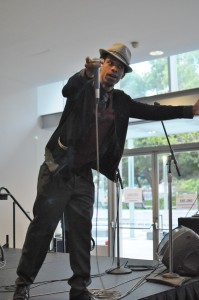
Artist and photographer Sanaz Mazinani performs a “mic check” at the Occupy Bay Area art show on July 14, 2012 at Yerba Buena Center for the Arts in San Francisco. Photo by Shane Menez, Fog City Journal.
By Brian Rinker
July 9, 2012
Schoolteacher Sage Nolan knew something about the financial crisis gripping the country.
She had seen budget cuts diminish resources needed to properly educate special needs children and had overheard reports about the Occupy movement, but its message never hit home — until Saturday night.
“What the heck is going on?” Nolan asked out loud. “When did all this start to take effect and where was I?”
Saturday evening, the Yerba Buena Center for the Arts unveiled Occupy Bay Area — an exhibit showcasing political posters, photos and videos of the movement’s guiding principles — with an opening night celebration that included live performances by local artists dedicated to social change.

Artist Jon-Paul Bail shows his Hella Occupy poster at the Occupy Bay Area art show on July 14, 2012 at the Yerba Buena Center for the Arts in San Francisco. Photo by Shane Menez, Fog City Journal.
Besides the few eruptions of “mic check” followed by staged performances of Occupy-like general assemblies, and the end of the night hip-hop performances where a handful of people gathered to dance, the crowd primarily focused on the variety of political poster art.
Divided into four categories — encampment, direct democracy, strategy and self-organizing — the posters represent a historic timeline of the movement.
Visual Arts Director Betti-Sue Hertz and assistant Amanda Verwey combed the Internet for Occupy-related art and reached out to local artists for material. They gathered more than 50 political posters emblematic of the movement’s social messages from 25 Bay Area graphic designers.
Popular poster illustrator Chuck Sperry felt the motives behind Occupy were overshadowed by the negative publicity it has received.
The Occupy Movement in the Bay Area commanded national scrutiny last fall when a series of clashes erupted between protesters and police in Oakland and on the UC Berkeley campus. The violence reported by the mainstream media influenced many to become skeptics of the movement.
When Sperry saw the public stance toward Occupy turn negative, he decided to do something about it.
“I thought, let’s do a bright sunny poster about Occupy,” Sperry said, “something positive.”
Sperry brought a number of his brightly colored orange and yellow prints that are on display at the museum and handed them out for free.
Before he created a poster for Occupy, Sperry already believed in its message: Economic inequality was growing wider and corporate and government corruption, including the mortgage crisis of 2008, had taken its financial toll. Then came Occupy.
Demonstrators were “shouting out at the system and were all yelling a big ‘no’ in unison,” Sperry said. “I related with that” and “I wanted in.”
The movement encompassed people and perspectives from various sectors of society. Demonstrators struggled over how to get their messages across.
That is when Occupy Design was born. Adam Levitas helped design many of the simple, black and white info-graphics for Occupy that hung on the walls.
“It is easy to dismiss people when they are holding a cardboard sign with writing in lipstick on it,” Levitas said, adding that it is much harder to argue with a more professional looking info-graphic.
The posters are marketing for the movement and info-graphics make complicated concepts more digestible for larger audiences.
In the past, Levitas added, marketing tools like this were only available to other side — the one percent.
Although Nolan said she probably would never have participated in an Occupy event, she found the exhibit, its color and depth, powerful and inspiring.
“It has made me think about all that has been taken from us,” she said. “From me.”
But not everyone was enthusiastic about the art or the Occupy movement.
Maryann Brooks handed out fliers that said black people were the one percent within Occupy and said she thought much of the art was directed more toward a white audience.
The American Dream is for white people, not blacks, she said.

Oakland rapper Davin “Do D.A.T.” Anthony Thompson performs at the Occupy Bay Area art show on July 14, 2012 at the Yerba Buena Center for the Arts in San Francisco. Photo by Shane Menez, Fog City Journal
The exhibition should have involved more collective, community-based art, she added, instead of the multitude of individual works of art, which made up the majority.
“As a black woman living in San Francisco, we are being erased,” said Brooks, a performance studies graduate student. “The economic inequalities are so intense here, I feel like all the people here are broken.”
The exhibition also included historic posters and photos reminiscent of previous political struggles in the area. These included posters about the ARC/AIDS Vigils at City Hall from the late 1980s to early 1990s, International Hotel evictions in Manilatown in 1977, photos of the Black Panther Party and a few other large protests that took place in the 1960s.
The exhibition runs through October 14.


 The Hunger Site
The Hunger Site
July 13, 2012 at 2:28 pm
hey,
sad to think that you thought that our showering of photos on the offensively contrived GA was staged…it wasn’t. it was an outraged outcry about the lack of representation of the occupy movement. I’ve been documenting the progressive movement for 10 years and am so glad that I chose to become an occupier. and I really wish that there was a deeper look at what we are and what we are trying to do. shame on you. My name is Kelly Johnson and the image that that show presented was shallow and irrelevant. you probably should have known that
July 11, 2012 at 7:10 pm
hahahhaha things move so fast, remember the “occupy” movement?
July 10, 2012 at 11:42 am
The photo above the article is actually of the David Shrigley show, also at YBCA right now. But nice article.
July 9, 2012 at 11:32 pm
The Philadelphia National Gathering Reveals Occupy’s Law of Entropy
A disappointing turnout of true believers this Fourth of July week exemplifies how – and why – the movement has lost its mojo
https://www.commondreams.org/view/2012/07/05-8